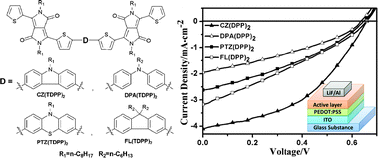A series of novel A–D–A structured small molecule photovoltaic (PV) materials [CZ(TDPP)2, DPA(TDPP)2, PTZ(TDPP)2 and FL(TDPP)2] with diketopyrrolopyrrole (DPP) as an electron-withdrawing group were synthesized and characterized. These small molecular donors exhibit excellent solubility in common organic solvents. The density functional theory (DFT) calculations demonstrated the intramolecular charge transfer (ICT) behavior of the synthesized PV materials and an efficient charge separation was observed by a fluorescence quenching experiment. In addition, their photophysical and electrochemical properties show that they harvest sunlight over the entire visible spectrum range and keep appropriate energy levels to satisfy the requirement of solution-processable OSCs. Therefore, we explored the PV properties of the synthesized donors by fabricating BHJ solar cells with a typical structure of ITO/PEDOT:PSS/Donors:PC61BM/LiF/Al. Among them, CZ(TDPP)2 revealed a promising performance in PV devices with a power conversion efficiency (PCE) of 1.50%, along with an open-circuit voltage (VOC) of 0.66 V, a short-circuit current density (JSC) of 4.12 mA cm−2, and a fill factor (FF) of 0.44, under an illumination of AM 1.5G (80 mW cm−2).

You have access to this article
 Please wait while we load your content...
Something went wrong. Try again?
Please wait while we load your content...
Something went wrong. Try again?


 Please wait while we load your content...
Please wait while we load your content...